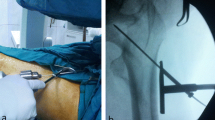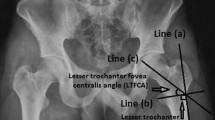Abstract
We compared a minimally invasive surgical technique to the conventional (open approach) surgical technique used in fixation of hip fractures with the dynamic hip screw (DHS) device. Using a case-control design (44 cases and 44 controls), we tested the null hypothesis that there is no difference between the two techniques in the following outcome measures: duration of surgery, time to mobilisation and weight bearing postoperatively, length of hospital stay, mean difference of pre- and postoperative haemoglobin levels, position of the lag screw of the DHS device in the femoral head, and the tip–apex distance. The minimally invasive DHS technique had significantly shorter duration of surgery and length of hospital stay. There was also less blood loss in the minimally invasive DHS technique. The minimally invasive DHS technique produces better outcome measures in the operating time, length of hospital stay, and blood loss compared to the conventional approach while maintaining equal fixation stability.
Résumé
Ce travail a pour but de comparer les techniques de fixation de fractures de la hanche par voie mini-invasive ou par voie d’abord conventionnelle avec utilisation de matériel de type DHS. Nous avons pour cette étude regroupé les patients en deux groupes, 44 cas par voie mini-invasive et 44 cas contrôle. Nous avons voulu tester l’hypothèse suivante: existe-t-il une différence entre ces deux techniques, sur la durée d’intervention, de reprise de l’appui post-opératoire; de durée moyenne de séjour des pertes sanguines notamment et enfin, en ce qui concerne la position de la vis céphalique dans la tête fémorale et sa distance par rapport à l’interligne. La technique mini-invasive entraîne de façon significative un temps chirurgical diminué et une diminution de la durée moyenne de séjour. Ceci est également vrai pour les pertes sanguines. Cette technique est pour nous supérieure en ce qui concerne ces items si on la compare à l’abord de type conventionnel en sachant que les problèmes de stabilité du matériel sont identiques quelle que soit la technique utilisée.
Similar content being viewed by others
References
Alobaid A, Harvey EJ, Elder GM, Lander P, Guy P, Reindl R (2004) Minimally invasive dynamic hip screw: prospective randomized trial of two techniques of insertion of a standard dynamic fixation device. J Orthop Trauma 18:207–212
Baumgaertner MR, Curtin SL, Lindskog DM, Keggi JM (1995) The value of the tip-apex distance in predicting failure of fixation of peritrochanteric fractures of the hip. J Bone Joint Surg Am 77:1058–1064
Bolhofner BR, Russo PR, Carmen B (1999) Results of intertrochanteric femur fractures treated with a 135-degree sliding screw with a two-hole side plate. J Orthop Trauma 13:5–8
Boufous S, Finch CF, Lord SR (2004) Incidence of hip fracture in New South Wales: are our efforts having an effect? Med J Aust 180:623–626
Brandt SE, Lefever S, Janzing HM, Broos PL, Pilot P, Houben BJ (2002) Percutaneous compression plating (PCCP) versus the dynamic hip screw for pertrochanteric hip fractures: preliminary results. Injury 33:413–418
Clague JE, Craddock E, Andrew G, Horan MA, Pendleton N (2002) Predictors of outcome following hip fracture. Admission time predicts length of stay and in-hospital mortality. Injury 33:1–6
Craig NJ, Maffulli N (2005) Subtrochanteric fractures: current management options. Disabil Rehabil 27:1181–1190
DiPaola M, Rozbruch SR, Helfet DL (2004) Minimal incision technique using a two-hole plate for fixation of stable intertrochanteric hip fractures. Orthopedics 27:270–274
Dougall TW, Duthie R, Maffulli N, Hutchison JD (1996) Antibiotic prophylaxis: theory and reality in orthopaedics. J R Coll Surg Edinb 41:321–322
Douglas S, Bunyan A, Chiu KH, Twaddle B, Maffulli N (2000) Seasonal variation of hip fracture at three latitudes. Injury 31:11–19
Ingman AM (2000) Percutaneous intramedullary fixation of trochanteric fractures of the femur. Clinical trial of a new hip nail. Injury 31:483–487
Kyle RF, Gustilo RB, Premer RF (1979) Analysis of six hundred and twenty-two intertrochanteric hip fractures. J Bone Joint Surg Am 61:216–221
Laohapoonrungsee A, Arpornchayanon O, Phornputkul C (2005) Two-hole side-plate DHS in the treatment of intertrochanteric fracture: results and complications. Injury 36:1355–1360
Maffulli N, Dougall TW, Brown MT, Golden MH (1999) Nutritional differences in patients with proximal femoral fractures. Age Ageing 28:458–462
McLoughlin SW, Wheeler DL, Rider J, Bolhofner B (2000) Biomechanical evaluation of the dynamic hip screw with two- and four-hole side plates. J Orthop Trauma 14:318–323
Parker MJ, Handoll HH, Griffiths R (2004) Anaesthesia for hip fracture surgery in adults. Cochrane Database of Systematic Reviews CD000521
Peyser A, Weil YA, Brocke L, Sela Y, Mosheiff R, Mattan Y, Manor O, Liebergall M (2007) A prospective, randomised study comparing the percutaneous compression plate and the compression hip screw for the treatment of intertrochanteric fractures of the hip. J Bone Joint Surg Br 89:1210–1217
Rose S, Maffulli N (1999) Hip fractures. An epidemiological review. Bull Hosp Jt Dis 58:197–201
Shabat S, Mann G, Nyska M, Maffulli N (2005) Scoring systems to evaluate elderly patients with hip fractures. Disabil Rehabil 27:1041–1044
Shah MR, Aharonoff GB, Wolinsky P, Zuckerman JD, Koval KJ (2003) Outcome after hip fracture in individuals ninety years of age and older. J Orthop Trauma:S6–11
Tarantino U, Oliva F, Impagliazzo A, Mattei A, Cannata G, Pompili GF, Maffulli N (2005) A comparative prospective study of dynamic variable angle hip screw and gamma nail in intertrochanteric hip fractures. Disabil Rehabil 27:1157–1165
Verhofstad MH, van der Werken C (2004) DHS osteosynthesis for stable pertrochanteric femur fractures with a two-hole side plate. Injury 35:999–1002
Acknowledgements
Dr Ho completed this investigation as part of his requirement of his Research Module in Trauma and Orthopaedics. Dr Garau was recipient of a Research Studentship from the Societa’ Italiana di Ortopedia e Traumatologia (SIOT).
Author information
Authors and Affiliations
Corresponding author
Rights and permissions
About this article
Cite this article
Ho, M., Garau, G., Walley, G. et al. Minimally invasive dynamic hip screw for fixation of hip fractures. International Orthopaedics (SICOT) 33, 555–560 (2009). https://doi.org/10.1007/s00264-008-0565-4
Received:
Revised:
Accepted:
Published:
Issue Date:
DOI: https://doi.org/10.1007/s00264-008-0565-4




